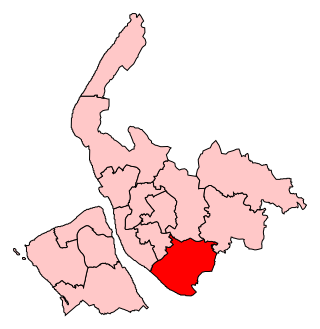Top Qs
Timeline
Chat
Perspective
Garston and Halewood
UK Parliament constituency (2010–2024) From Wikipedia, the free encyclopedia
Remove ads
Garston and Halewood was a constituency[n 1] created in 2010 and was represented in the House of Commons of the UK Parliament since 2010 by Maria Eagle of the Labour Party.[n 2]
Following the 2023 Periodic Review of Westminster constituencies, the seat was abolished at the 2024 general election, with the majority (parts in the City of Liverpool) being included in the re-established constituency of Liverpool Garston. Halewood is included in the new constituency of Widnes and Halewood.[2]
Remove ads
History
- Creation
The seat was created for the 2010 general election during the Boundary Commission for England's review of constituencies.
- Political history
The 2015 re-election of frontbencher Maria Eagle (Lab) made the seat the 11th safest of Labour's 232 seats by percentage of majority.[3]
Boundaries
The City of Liverpool wards of Allerton and Hunts Cross, Belle Vale, Cressington, Speke-Garston, and Woolton, and the Metropolitan Borough of Knowsley wards of Halewood North, Halewood South, and Halewood West. The boundaries have been drawn to date almost square, favouring neither riverside nor inland reach.
The constituency covers most of the previous Liverpool Garston (part of the city of Liverpool), together with the most southerly part of the borough of Knowsley (previously in the Knowsley South constituency).
Remove ads
Constituency profile
Summarize
Perspective

Two parts of the political division are green — land surrounding its airport (including the National Trust for Places of Historic Interest or Natural Beauty's archetypal Tudor Speke Hall and grounds) and in the north east, parts of Hough Green and Tarbock Green. The remainder is urban and forms the southern tip of the Merseyside metropolitan county (of mid-size among the 1974-enacted units). The constituency as drawn stretches along the most up-river part of the Mersey Estuary before its brief start between Cheshire and the remainder of its former county of Lancashire, on a near-flat riverside. The history of the City of Liverpool (right) bank of the Mersey witnessed in the late 20th century the ceasing of shipbuilding and a sharp decline in trade, rail distribution and manufacturing prompting mass unemployment. Its now-modest socially rented housing stock alleviated overcrowding of Liverpool. The seat is centred approximately 5 miles (8.0 km) from the city centre. The constituency also includes Liverpool Airport
Deprivation is low for the metropolitan county and marginally higher than the region as a whole. As at the 2011 census 60% of housing was owner-occupied (compared to 64.5% in the North West of England region). At the same census 9.1% of households were deprived in three or the maximum of four dimensions measured by the ONS — in the region the figure is 7.0%.[4]
Members of Parliament
Elections
Elections in the 2010s
- * Served as an MP in the 2005–2010 Parliament
Remove ads
See also
Notes
- A borough constituency (for the purposes of election expenses and type of returning officer)
- As with all constituencies, the constituency elects one Member of Parliament (MP) by the first past the post system of election at least every five years.
References
External links
Wikiwand - on
Seamless Wikipedia browsing. On steroids.
Remove ads



